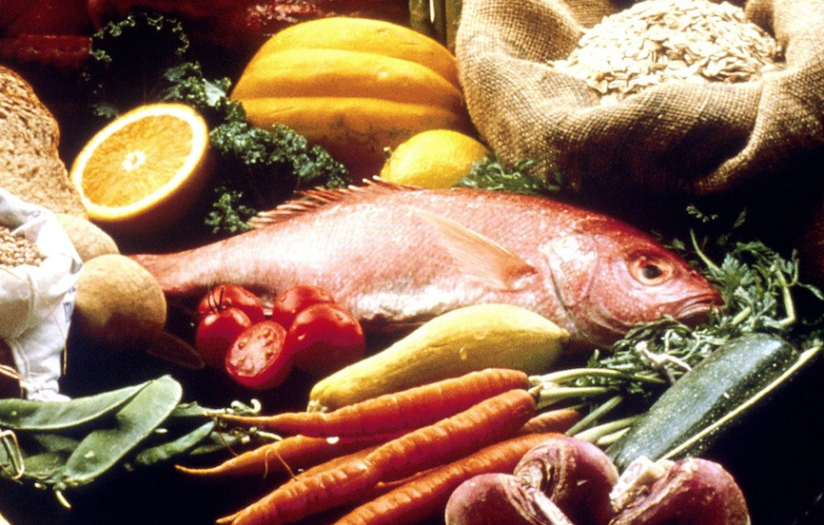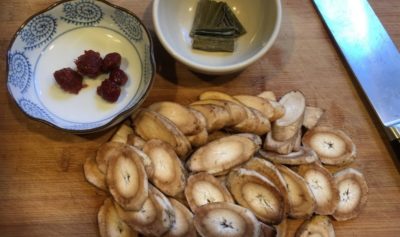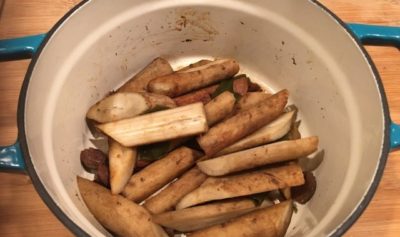For those of you who love to eat fish, especially carp or salmon, this is a traditional strong nourishing fish soup that you may like to try out. This nourishing yang fish soup dish balances the gentle yin yuki no nabe (pot of snow) or the daikon-tofu dish.
It is best to use a whole fish to cook this nourishing fish soup or stew. You need to cook the fish slowly with enough liquid in a closed pot, preferably in a pressure cooker.
Pressure-cooking not only helps to retain all the goodness of the fish and the root vegetables. It also softens the fish bones, making the soup a mineral-rich broth and a good source of nutrients, such as high quality protein and omega-3 fatty acids.
You can use a whole carp or salmon. If you choose salmon, make sure to buy wild-caught salmon instead of farmed salmon whenever possible. This is because farm-raised salmon tend to have more toxins, artificial dyes, antibiotics, and more fat due to their crammed living enclosures.
Benefits of Nourishing Fish Soup
Traditionally, this fish dish was specially for women after childbirth to help nourish and replenish their energies.
Today, everyone can enjoy this belly-warming and nourishing fish soup. It is great for chilly winter nights when you need something warm and nurturing.
This dish is my go-to nourishing fish soup. When I feel a little run-down and need some tonifying foods, this nourishing fish soup is usually my first choice.
If you just wish to balance the yin and yang of foods, then prepare this nourishing fish stew to go with the daikon-tofu dish. It is also called yuki no nabe in Japanese or a pot of snow because the daikon and tofu are both pale and white.
Utensils
- Pressure cooker
- Metal flame defuser if you have a gas stove
Ingredients for Nourishing Fish Soup
- 1 cup of burdock (julienned or finely shaved)
- 1 cup of carrots (julienned)
- 1 cup of used/recycled Japanese green tea, Kukicha twigs, or bancha
- 1 whole fish about 12 inches to 14 inches long (carp or salmon)
- Water to cover 3/4 of the fish
- 1 tablespoon of red miso
It is best to used Kukicha twigs or bancha tea. Place the twigs in a tiny muslin pouch so that you don’t have the tiny twigs floating in the soup. You can order Kukicha twigs online or look for them in a Japanese grocery store.
Alternatively, you can replace the twig tea with a couple of used Japanese green tea bags, if you cannot find Kukicha or bancha tea.
Method
- Scrub burdock with a vegetable brush (without peeling off the skin), then julienne or shave into tiny leaf-like slices.
- Wash and julienne the carrot.
- Clean fish and leave the head intact.
- Place fish in the pot with the burdock, carrots, and used kukicha twigs or green tea bag.
- Add enough water to cover three-quarters of the fish.
- Cover and place pressure cooker on medium to high flame to bring the pressure up.
- Then reduce the heat to low and place the flame diffuser on a gas burner, or turn an electric burner to low under the pressure cooker.
- Let the fish cook under high pressure for about 45 minutes to an hour.
- Turn off the heat and wait for the pressure to go down.
- Add some water to the tablespoon of miso to form a paste. Then stir the miso paste into the nourishing fish broth, and simmer for about five minutes.
- Serve warm with noodles or brown rice.
Drink the nourishing fish broth and eat the vegetables with the fish meat, which should be soft and tender.
When to Make the Nourishing Fish Soup?
This nourishing fish soup has a warming yang effect on the body. It should not be eaten too frequently, especially during the hot summer months. Nor should you eat this nourishing fish broth with too many other yang foods, such as barbecued or grilled meats.
In traditional households, unlike the adzuki-pumpkin dish, this nourishing fish stew is not an everyday dish. This fish broth is a delicacy that is relished intermittently for strengthening our body or during the cooler months of the year.
 Dr. Margaret TreyAuthor, Researcher & Wellness Advocate
Dr. Margaret TreyAuthor, Researcher & Wellness Advocate






